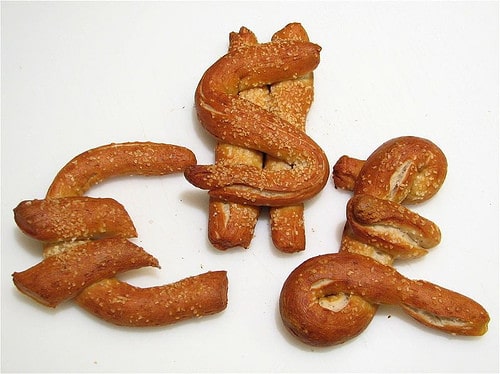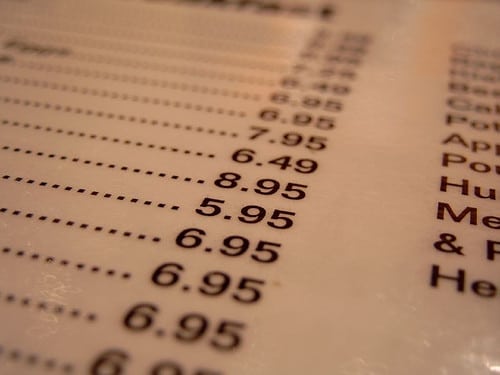Converting foreign prices into your home currency and adding its symbol (i.e. $, €, £) to menu prices, bar tabs, and grocery bills may be enough to trick your mind into spending much less money.

People tend to spend significantly more, no matter what the currency, when prices are displayed without symbols and even more when prices are rounded off or don’t have decimal points. This effect is amplified when the symbols you do read aren’t local to you (like seeing Euro signs when visiting France from the United States).
 How To Trick Your Mind With Your Local Currency Symbol
How To Trick Your Mind With Your Local Currency Symbol
Even travelers who are conscious of their budgets tend to spend more money when doing quick conversions in their heads. To best overcome the symbol effect discovered by Cornell University, it’s best to accurately convert a given price down to the decimal in your home currency, and write it with the appropriate symbol preceding it.
For example, 12 for a salad on a menu might be easy on the eyes, but try writing it as $12 or even better $12.00.
Useful Tools To Converting Prices On The Spot
These are some tools you can use to get accurate currency conversions close to real time so you can save yourself from the “dollar effect”.
 Currency – One of 5 free and useful iPhone apps for travelers, the Currency iPhone app converts in real time and stores the information for quick viewing, even when you don’t have Internet access. (Works on the iPod touch as well.)
Currency – One of 5 free and useful iPhone apps for travelers, the Currency iPhone app converts in real time and stores the information for quick viewing, even when you don’t have Internet access. (Works on the iPod touch as well.)- Google – Simply type how much and the currencies you want to convert in the Google search box. For example, “convert 5 USD to GDP”.
- Currency Converter Mac Dashboard Widget – Converts almost all international currencies as well as legacy ones (e.g. German Deutsch mark).
- Currency Converter Gadget Windows 7 – Very similar to the Mac version.
For those of you who don’t have smart phones or dislike carrying them on you, a simple pen and paper with common conversions may help you when ordering a meal that’s “not too expensive.” When all else fails, simply adding a dollar sign next to the prices on any menu (or handy napkin nearby) is likely to subconsciously make you spend less.
Working Against You At Home Too
While the added layer of operating with foreign currency will increase your tendency to spend, the lack of dollar signs has the same effect for you at home too. Hotel and restaurant owners are keening aware of this and manipulate their advertisements and menus to nudge you into spending a few extra bucks. So next time you see a nice rounded off price, convert it into the currency you grew up with (or get paid in) and add the appropriate symbol. Also, don’t forget to add two decimal points over to save even more on your simple travel budget.
[photos by: deltaMike (dollar sign glasses), oskay (pretzel money symbols), cheap eats (menu prices)]












Hope this works for me! 😉
The best part is that it’s free to try 🙂
Never thought about making sure to add currency signs! I’m going to definitely try it out when I stumble upon this.
Funny how the mind works but an effective trick!
Oh…that brain is a tricky little bugger. I think I always convert to US dollars and then put in terms of other things I could buy to stay traveling longer!
Good trick, especially helpful in Europe where the prices seem very inflated!
I guess like most that I convert to my local currency. I will start to add currency signs where relevant – I’d never heard of that brain phenomenon.
It reminds me of something like cursing or hearing curses in another non-native language. Doesn’t quite have the same effect or emotional impact.
Hi Anil!
This is a little trick I have been applying for many years and does work quite well. In places where the currency is not much different from the USD (doing this with Kip in Lao or Baht in Thailand doesn’t work too well) it it is a handy solution to a common problem.
Another index I use to compare prices is the well known Big Mac index. If the country you are in has McDonald’s check how much the Big Mac menu costs in local currency. You now know what the same thing u get at home costs here, and thus is a good way of comparing other items later on.
Good post!
Federico
I’ve heard of that, there’s an iPod index too I think 🙂 Personally bread and Coca-cola are my internal (albeit highly inaccurate) gauges.
Here’s an excellent free Web app you can use as well to get prices on all sorts of things:
http://www.techguidefortravel.com/2010/03/23/estimate-travel-costs-with-web-app-budget-your-trip/